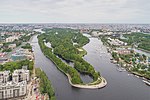Serafimovskoe Cemetery

Serafimovskoe Cemetery (Russian: Серафимовское кладбище) is a historic cemetery in northwestern Saint Petersburg, in Primorsky District. It was established to meet the need for the growing population in the early twentieth century. The first burial took place in 1905, and the cemetery church, the Church of Seraphim of Sarov in the Serafimovskoe Cemetery, was consecrated in 1907. The cemetery was primarily a burial place for the poor, until the Second World War. During the siege of Leningrad, from 1941 to 1944, it was one of the main sites for burying those who were killed, or died of cold or starvation. At least 100,000 people were buried during this period, mostly in mass graves. The cemetery expanded after the war, and today covers 59 hectares. It contains the graves of a wide range of society, including military figures, and prominent people from the arts, sciences and sports.
Excerpt from the Wikipedia article Serafimovskoe Cemetery (License: CC BY-SA 3.0, Authors, Images).Serafimovskoe Cemetery
Центральная дорога, Saint Petersburg
Geographical coordinates (GPS) Address Nearby Places Show on map
Geographical coordinates (GPS)
| Latitude | Longitude |
|---|---|
| N 59.994166666667 ° | E 30.265277777778 ° |
Address
Центральная дорога
197227 Saint Petersburg (округ Озеро Долгое)
Saint Petersburg, Russia
Open on Google Maps










